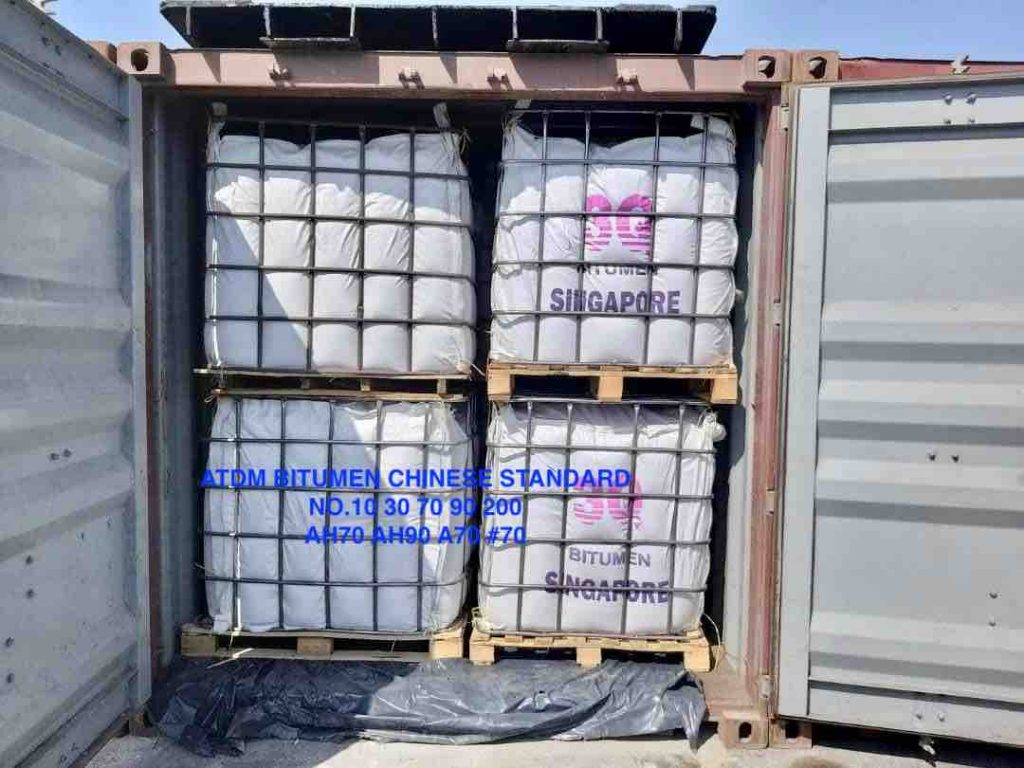
China bitumen production capacity
ATDM is main bitumen supplier in china since 2006 Chinese bitumen manufacturer producing 33 million tons of bitumen annually and importing 20 million tons also from Iran, Korea and Thailand in bag, drum, flexi and bulk vessel.
We export bitumen to china with Chinese standards.
As of my last knowledge update in January 2022, the specific standards for bitumen in China may be subject to updates or changes. However, as of that time, bitumen standards in China were mainly governed by the following specifications:
Differences of ASTM with Chinese standard?
The main items is ductility that in Chinese standard at 15 centigrade should be 100cm but ASTM standard at 25C is 100CM and the rest index is same.
Question on different grade of bitumen in China
1. Different penetration levels
The penetration of No. 30 asphalt is 20~40.
The penetration of No. 70 asphalt is 60~80.
2. Different ductility
The ductility of No. 30 asphalt is ≥ 50.
The penetration of No. 70 asphalt is ≥100.
3. Different softening points
The softening point of No. 30 asphalt is 55~72.
The softening point of No. 70 asphalt is 44~54.
1. The softening points of 70# asphalt and 90# asphalt are different.
(1) The softening point of 70# asphalt is 46 degrees Celsius.
(2) The softening point of 90# asphalt is 45 degrees Celsius.
2. The penetration of 70# asphalt and 90# asphalt is different.
(1) The penetration of 70# asphalt is 60-80.
(2) The penetration of 90# asphalt is 80-100.
3. The ductility of 70# asphalt and 90# asphalt is different.
(1) The ductility of 70# asphalt is 25.
(2) The ductility of 90# asphalt is 45.
4. The dynamic viscosity of 70# asphalt and 90# asphalt are different.
(1) The dynamic viscosity of 70# asphalt is 180Pa·s.
(2) The dynamic viscosity of 90# asphalt is 160Pa·s.
Usage of different grade of bitumen in different province of china
Shandong province bitumen supplier
Petroleum Asphalts for Heavy Traffic Road Pavement
GB/T 15171-2017: Asphalt for Road and Bridge Construction: This standard specifies the requirements, test methods, inspection rules, marking, packaging, transportation, storage, and quality certificate of asphalt for road and bridge construction.
GB/T 8161-2008: Test Method for Determination of Fraass Breaking Point of Bitumen: This standard specifies a method for determining the Fraass breaking point of bitumen.
GB/T 4509-2010: Test Methods for Softening Point of Bitumen (Ring-and-Ball Apparatus): This standard specifies the test method for the determination of the softening point of bitumen using the ring-and-ball apparatus.
GB/T 4508-2010: Test Methods for Penetration of Bitumen: This standard specifies the test method for the determination of the penetration of bitumen.
Popular bitumen specification in China
Item | JTG F40-2004 Technical requirements | ATDM | |
Penetration (25℃, 100g, 5s), 0.1mm | 60~80 | 77 | |
Penetration Index (PI) | -1.5~+1.0 | -0.97 | |
Softening Point (ring and ball method), ℃ | ≥46 | 48.0 | |
Extensibility (10℃, 5cm/min), cm | ≥20 | 84 | |
Extensibility (15℃, 5cm/min), cm | ≥100 | >100 | |
Dynamic Viscosity at 60℃, Pa.s | ≥180 | 211.5 | |
Flash Point, ℃ | ≥260 | 334 | |
Solubility, % | ≥99.5 | 99.96 | |
Density (15℃), g/cm3 | Measured Value | 1.038 | |
Wax Content, % | ≤2.2 | 2.1 | |
Thin Film Oven 163℃, 5h | Quality Change, % | ±0.8 | -0.302 |
Penetration Ratio, % | ≥61 | 64.9 | |
Extensibility (10℃), cm | ≥6 | 7 | |
90A bitumen or Bitumen AH90
Item | JTG F40-2004 Technical requirements | ATDM | |
Penetration (25℃, 100g, 5s), 0.1mm | 80~100 | 92 | |
Penetration Index (PI) | -1.5~+1.0 | -0.93 | |
Softening Point (ring and ball method), ℃ | ≥45 | 46.5 | |
Extensibility (10℃, 5cm/min), cm | ≥45 | >100 | |
Extensibility (15℃, 5cm/min), cm | ≥100 | >100 | |
Dynamic Viscosity at 60℃, Pa.s | ≥160 | 179.6 | |
Flash Point, ℃ | ≥260 | 331 | |
Solubility, % | ≥99.5 | 99.94 | |
Density (15℃), g/cm3 | Measured Value | 1.035 | |
Wax Content, % | ≤2.2 | 1.7 | |
Thin Film Oven 163℃, 5h | Quality Change, % | ±0.8 | -0.046 |
Penetration Ratio, % | ≥57 | 69.6 | |
Extensibility (10℃), cm | ≥8 | 14 | |
Item | JTG F40-2004 I-C Technical requirements | JTG F40-2004 I-D Technical requirements | Modified bitumen of ATDM | Basekim Modified bitumen | |
Penetration (25℃, 100g, 5s), 0.1mm | 60~80 | 40~60 | 76 | 51 | |
Penetration Index (PI) | ≥-0.4 | ≥0 | +1.04 | +0.31 | |
Softening Point (ring and ball method), ℃ | ≥55 | ≥60 | 79.5 | 84.5 | |
Extensibility (5℃, 5cm/min), cm | ≥30 | ≥20 | 42 | 30 | |
Kinematic Viscosity (135℃), Pa.s | ≤3 | ≤3 | 1.8 | 2.3 | |
Flash Point, ℃ | ≥230 | ≥230 | 327 | 302 | |
Solubility, % | ≥99 | ≥99 | 99.88 | 99.70 | |
Elastic Recovery (25℃), % | ≥65 | ≥75 | 95 | 96 | |
Separation, 48h Softening Point Difference, ℃ | ≤2.5 | ≤2.5 | 0.2 | 0.4 | |
Thin Film Oven 163℃,5h | Quality Change, % | ±1.0 | ±1.0 | +0.011 | -0.04 |
Penetration Ratio, % | ≥60 | ≥65 | 78 | 76 | |
Extensibility (5℃), cm | ≥20 | ≥15 | 26 | 17 | |